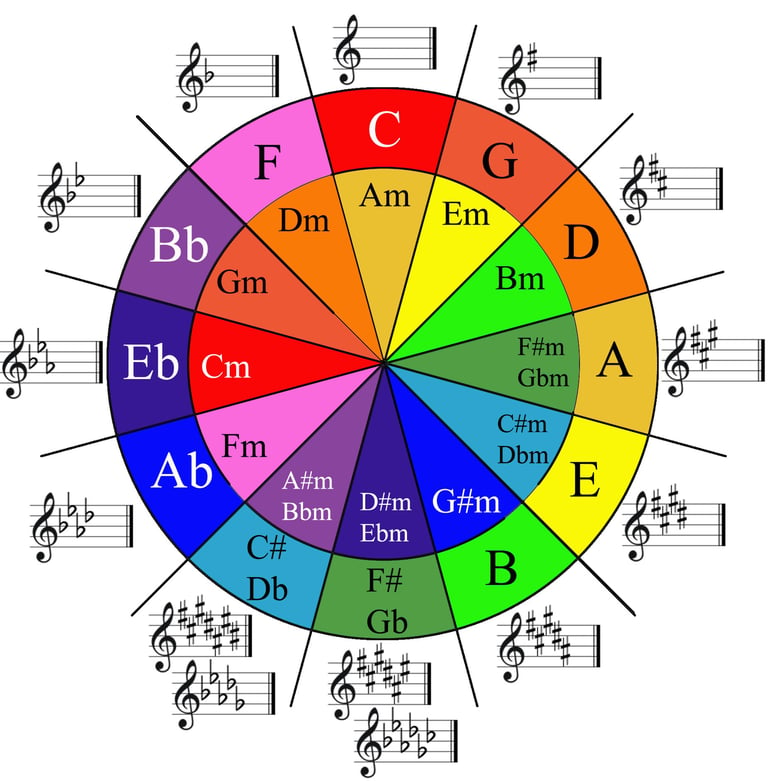Guidelines for the Young Violinist 🎶
Techniques Starting From Age 6+
Scales: One / Two Octaves
Mastering scales is essential for developing finger placement and intonation. Here are the scales to focus on:
G Major: F♯
D Major: F♯, C♯
A Major: F♯, C♯, G♯
A Flat Major: A♭, B♭, D♭, E♭
B Major: C♯, D♯, F♯, G♯, A♯
B Flat Major: B♭, E♭
C Major
E Major: F♯, C♯, G♯, A♯
Minor Scales: Natural, Harmonic, and Melodic
Each minor scale offers a unique sound and is crucial for musical expression.
A Minor
B Minor: C♯, F♯
C Minor: E♭, A♭, B♭
D Minor: B♭
E Minor: F♯
G Minor: E♭
Bow Technique
Developing bow technique is key to producing a beautiful sound. Explore these techniques:
Detache: Long or short bows for smooth transitions.
Staccato: Short, distinct strokes for clarity.
Legato/Slur: Connecting notes with a single bow movement.
Advanced Techniques:
Detache: Single, double, triple, quadruple notes.
Staccato: Single, double, triple, quadruple notes.
Legato: Two, four, eight, sixteen notes.
Connected and Separated Staccato:
Connected Staccato: AA, AAA, AAAA
Connected Staccato Varied: AB, ABC, ABCD
Separated Staccato: A, AA, AAAA
Patterns:
Legato Patterns: AB, ABC, ABCD
Long Short Short: Aaa Bbb
Staccato Long Short Short
Connected Short: Aaa (Down A, up up a)
Reverse Short Short Long: aaA, bbB, ccC or aaB, bbC, ccD, ddE, eeF
Actionable Steps for Young Violinists:
Daily Practice: Encourage regular practice to build muscle memory.
Listen and Imitate: Listen to professional recordings and try to imitate the tone and technique.
Focus on Posture: Maintain correct posture to avoid strain and improve playing.
Different Perspectives:
Rare Case: Some young students may prefer focusing on a few scales deeply rather than many at once.
Alternative Opinion: Incorporating fun pieces alongside scales can increase motivation and engagement.
Beginner Ages 6-9 🎶
Starting with the basics, these materials will help build a solid foundation:
Essential Elements Books 1, 2, 3
Suzuki Book 1, 2
60 Studies, Op. 45 by Wohlfahrt
Intermediate Ages 9-12 🎻
This stage introduces more complex pieces and techniques:
Circle of Fifth
Suzuki Books 3, 4, 5
Indian War Dance from the Indian Concertino by Perlman
Morrison’s Jig
Solos and Etudes by Gerald Anderson and Frost
Hohmann's Practical Method for the Violin - Shimer
Solos for Young Violinist - Selections by Barber
Concertos and Pieces:
Rieding Violin Concerto in B Minor, Op. 25 (Dark and stormy mood)
Hans Millies Violin Concertino in D Major (Classical style, like Mozart)
Seitz Student Violin Concerto No. 2, Op. 13 (Adagio, technical)
Leo Portnoff Concertino in E Minor, Op. 13 (Dramatic genre)
Adolf Huber Student Violin Concerto No. 4, Op. 8 (Double string, flowing melodies)
Additional Genres:
Irish Tunes
Jazz Tunes
Technique Introductions:
Vibrato Introduction
Second and Third Positions
Advanced Repertoire 🌟
For those advancing further, these pieces offer rich challenges and experiences:
Allegro and Prelude - Kreisler
24 Etudes - Kreutzer
The Four Seasons - Vivaldi
Violin Concertos by Mozart
Violin Concerto No. 1 - Bruch
Violin Concerto - Khachaturian
Violin Concerto in D Major - Brahms
Sonatas and Partitas by Bach
Bossa Nova Collection from Tom Jobim
Irish Tunes and Gigs
Actionable Steps:
Daily Practice: Encourage regular practice of scales and pieces.
Listening Sessions: Engage students with recordings of professional performances.
Integration: Mix genres to keep practice sessions exciting and varied.
Different Perspectives:
Rare Case: Some students may prefer focusing deeply on specific genres, while others might enjoy a broad exploration.
Alternative Opinion: Some educators integrate improvisation early to develop creativity alongside technical skills..






